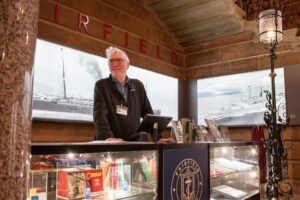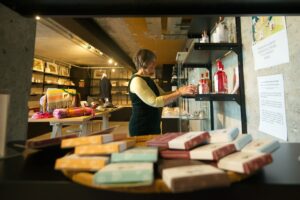Creating an equitable museum workplace
Rachel Backshall, Assistant Director at The Scottish Crannog Centre talks about the museum’s approach to Fair Work and how they have created an equitable workplace where everyone can participate, express themselves, contribute, and feel valued.

In brief
- The Scottish Crannog Centre have a people centred and collaborative approach within their workforce with social justice and Fair Work as core values
- Their way of working has created an inclusive and welcoming environment where staff and volunteers are motivated and free to explore interests within their roles
- The museum successfully reopened at a new site earlier this year after a large capital project, their adaptive and resilient team are a testament to the success of their reopening
Background
Social justice and Fair Work are at the heart of what we do at The Scottish Crannog Centre.
We believe that everyone should have the same opportunities to be all that they can be. We want to forge an equitable community in which anyone can actively participate. This is a people-centred approach that works towards creating a society where anyone can express themselves, contribute, be valued, and be happy.
We take a co-operative approach, co-designing who we are and what our purpose is – developing shared articulation and shared language. Shared values encapsulate this, shared care for each other and for the collection of 2500-year-old objects that we hold in our museum. From volunteers to the director, these values are lived – our shop manager brings in pork pies for an apprentice who forgets his lunch, our 1-2-1 lead made soup for staff and volunteers during winter so everyone had hot food for 20p each day. This is led by a culture, and a community, not an agenda or policy.
“I found the Crannog Centre very welcoming and felt I fitted in straight away. I have been able to have a go at all sorts of things, which has increased my employability skills, improved my confidence, and I have found a place to fit.”
Rebecca Davies, Leather Worker
We are a small team of 27 staff, employing brilliant people with a range of support needs. We deliver apprenticeships and work placements in customer service, museum practice, and woodland management, as well as work placements, volunteer opportunities, and 1-2-1 learning with the local school.
We believe that by having a diverse team we can best connect to the diverse audiences that we serve as a museum – creating and sustaining opportunities for people of different abilities, ages, sexualities, and backgrounds. A diverse workforce is not something that is ‘nice to have’, not a corporate responsibility, rather it is bringing in assets to the organisation that will drive it further. It’s a ‘must-have’ and a core part of our organisation. We aim to create an organisation where there are a thousand fingerprints and a thousand voices involved in all we do.
Successes
- Our staff have the freedom of self to explore interests within their role. An example of this is one of our apprentices, Toby, who became interested in woodturning during his digital marketing apprenticeship. He has since developed in-depth museum interpretation and displays on woodworking and is now training with green woodworking mentors on a new NPA qualification we have developed.
- New shared leadership, moving away from linear models of hierarchy to create a place where different people lead depending on the situation. Building our new museum really put this to the test. Co-designing with over 30 craftspeople, artists, architects, structural engineers, and archaeologists involved in planning, designing, and building our Iron Age village. Self-responsibility goes hand in hand with this, encouraging owning your actions and decisions – not being afraid to try.
- Effective voice and fulfilment extend into our external partnerships. Strategic partners want to work with us because they feel welcome and able to contribute. This ties into social responsibility, reflecting on ‘what is our purpose?’ and listening to the voices of the team on this.
Challenges
- Hierarchy and exclusion – attitudes of superiority to volunteers and apprentices are no good!
- People who want to put people into boxes – when we have no boxes here – just individuals with individual talents and brilliance.
- The dangers of thinking we know all and stopping learning, which leads to stopping listening, which leads to losing trust.
- Realising that this isn’t for everyone, but it should be for anyone! Some people prefer a strict hierarchy or prestige and struggle with this approach. This can distort the effectiveness of effective voice.
Impact
- More resilient – we survived COVID-19, a fire, a flood, and we have now built and opened a new museum and Iron Age Village (we are just waiting on a plague of locusts now!)
- We are more dynamic and responsive to change.
- Increased visitor numbers and increased partnerships – people want to work with us, to support us, and for us to support them. We are helping to advise other museums on becoming Disability Confident and how to set up and run apprenticeships.
- We have won a number of Awards with our approach, including:
- Number 9 in the top 10 visitor attractions in the UK on TripAdvisor 2022
- Finalists in the UK for the Disability Confident Impact award 2023
- Winners of the Museum and Heritage Best Visitor Welcome Award at the Trip Advisor Awards 2023
- Winners of the Sustainable Business Award at the Scottish Sustainability Awards 2023
- Winners of SME Employer of the Year Promoting Diversity in the Scottish Apprenticeship Awards 2023
- Joint winners of the Sustainable Project of the Year Award at the Museum + Heritage Awards 2024

Guidance for museums and galleries
- We can always do more! Working as a Disability Confident Leader and holding Young Persons Guarantee, we are constantly reflecting, evaluating, and making tweaks to keep us nimble on our feet and able to respond rapidly to change. During winter 2023, we were building towards opening our new museum at Dalerb. This process was challenging for members of the team, so we worked with Perthshire Autism Support to help us with training and putting in extra support for those who needed it. A Trade Union also came to do a talk for us as part of the training.
- Not recruiting by competency but starting with raw talent. This is the opposite of the traditional business, and the typical museum structure is particularly poor at this – hierarchical, requirement for degrees, projects led by people with lived experience, but not employed by the organisation. Assets are normally the collection, but here the collection stands side by side with the people.
- When you say no one left behind, you have to mean it! We change our approach and support regularly to build in extra help when it is needed.
Additional information
Email: The Scottish Crannog team

